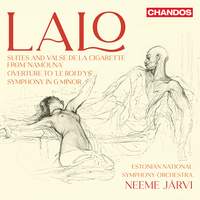Recording of the Week,
Lalo orchestral works from Neeme Järvi and the Estonian National Symphony Orchestra
The French musical establishment in Lalo’s time had a curious two-tier hierarchy - composers dubbed ‘symphonists’ were afterthoughts, with opera the goal for anyone who was (or aspired to be) anyone. Lalo both does and doesn’t fit this mould; trying his hand at opera but happy to repurpose the results into a symphonic work that ultimately proved more successful. Perhaps, ‘symphonist’ though he was, he had the last laugh - indeed, his cello concerto and Symphonie Espagnole remain popular today.
Having ventured into operatic composition, Lalo’s writings betray a certain bafflement at subsequently being commissioned to write not an opera but a ballet. After a number of setbacks this eventually took shape as the exotic romance Namouna, which enjoyed reasonable success against entrenched critical opposition. Lalo again had no qualms about ensuring his score would live on in the concert hall, reworking it as a pair of suites - plus the standalone Valse de la cigarette, a delicate number that was originally intended to form the starting-point of a third and offers the orchestral woodwind plenty of moments to shine.
Lalo’s orchestration is luscious and his melodies sweeping - the first suite’s Thême varié has some real Hollywood-style moments in which the strings audibly revel - and pictorial touches abound. Harp and pizzicato strings evoke a serenader’s mandolin; exotic percussion spices up the scenes set in half-imagined visions of distant lands (chiefly Morocco). There’s also a delightful passage for solo flute in the Parades de foire which one can imagine accompanying an intimate dance for the two lead characters.
Lalo is far less of an Impressionistic watercolourist than Fauré or Debussy, though in his own way just as evocative. I was reminded particularly of Rimsky-Korsakov’s 1888 Scheherazade, both in his turns of harmonic phrase and in his approach to orchestration, especially in the second suite’s stirring Mazurka. It’s true that occasionally (for example in the Prélude) a hint of the Flying Dutchman or the bridge to Valhalla also makes itself felt, leaving me just a little more sympathetic to those of Lalo’s contemporaries who criticised him as inappropriately Wagner-ified! Elsewhere he’s just as wedded as Saint-Saëns was to musical Orientalisms - his fiery Danses marocaines, where Järvi’s percussion and brass really make their presence felt, could easily be a lost movement from the Suite algérienne.
To his snobbish contemporaries Lalo may have been an also-ran, but it’s their loss; his Symphony in G minor is a marvel. It has the incredible misfortune to have premiered in 1886, the same year as both Saint-Saëns’s Organ Symphony and Franck’s Symphony in D minor, but I would rate it the equal of either. The first movement’s sombre opening mood flowers into some truly foreboding climaxes - though the sun pierces the clouds here and there. The Adagio is especially beautiful, featuring some gorgeously mellow brass and wind writing in support of the yearning string melodies.
I suspect that Lalo’s symphony suffers from how it ends - neither with a Franck-like peroration powered by the triumphant restatement of motifs from earlier movements, nor with a Saint-Saëns-style blaze of light elevated by the organ’s roar. His fourth movement is a relatively brief Allegro, giving the Vivace second movement a run for its money in vigour and liveliness and showing off the agility and precision of the wind and brass in particular. Perhaps juxtaposition with the other two symphonies makes this seem inconsequential, but it isn’t trying to make such an all-encompassing closing statement.
The symphony isn’t at all ashamed of its operatic ancestry; though it doesn’t inherit anything so clear-cut as a plot, there’s an indefinable ‘stage’ quality about it (particularly in that final movement, which I enjoy more and more each time I listen to it) that’s exciting, vivid and refreshing. Readers may recall that back in November I was impressed with Les Siècles’s performances of works from this period; exploring Lalo’s slightly different take on a similar sound-world has been an equally delightful journey.
Estonian National Symphony Orchestra, Neeme Järvi
Available Formats: CD, MP3, FLAC, Hi-Res FLAC




